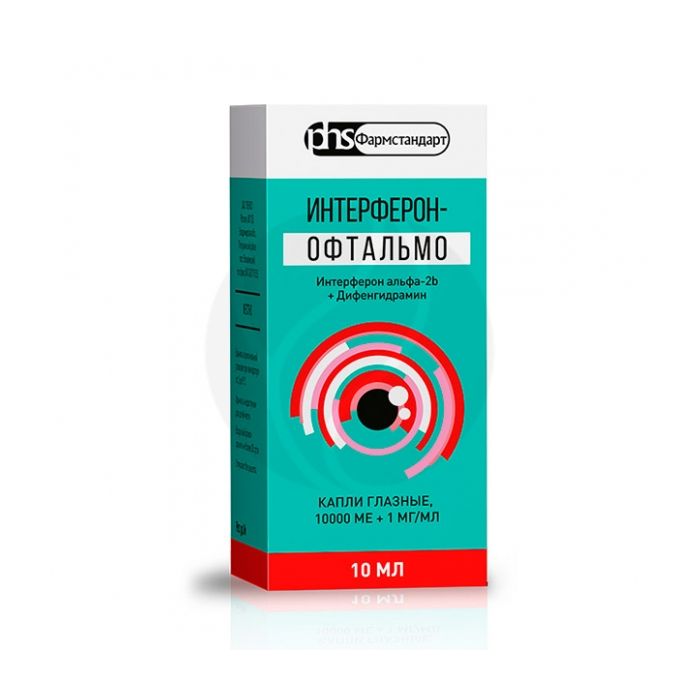Interferon Ophthalmo eye drops, 10ml
Expiration Date: 05/2027
Russian Pharmacy name:
Интерферон Офтальмо капли глазные, 10мл
Adenoviral, hemorrhagic (enteroviral), herpetic conjunctivitis;
adenoviral, herpetic (vesicular, punctate, treelike, cardiac) keratitis;
herpetic stromal keratitis with and without corneal expression;
adenoviral and herpetic keratoconjunctivitis;
herpetic uveitis;
herpetic keratouveitis (with and without manifestations);
dry eye syndrome;
prevention of graft disease and prevention of recurrence of herpetic keratitis after keratoplasty;
prevention and treatment of complications after excimer laser refractive surgery of the cornea.
Locally, in the conjunctival sac
In case of viral lesions of the eyes in adults and children in the acute stage of the disease, the drug is instilled into the conjunctival sac 1-2 drops up to 6-8 times a day. As the inflammatory process stops, the number of instillations is reduced to 2-3 times a day, until the symptoms of the disease disappear.
In case of 'dry' eye syndrome, the drug is used daily, instilling 1-2 drops into the sore eye 2 times a day for up to 25-30 days until the symptoms of the disease disappear.
For the prevention and treatment of complications after excimer laser refractive surgery of the cornea, the drug is used daily, instilling 1-2 drops into the eye 2 times a day, starting from the day after the operation for 10 days. For the prevention of graft disease and the prevention of recurrence of herpetic keratitis after keratoplasty, the drug is used daily, instilling 1-2 drops into the operated eye 3-4 times a day during the first two weeks after surgery.
If after treatment there is no improvement, or symptoms worsen, or new symptoms appear, you should consult your doctor. Use the drug only according to the indications, the route of administration and the doses indicated in the instructions.
Active ingredients:
human recombinant interferon alpha-2b - at least 10,000 IU, diphenhydramine hydrochloride -1.00 mg.
Excipients: hypromellose (hydroxypropyl methylcellulose) - 3.50 mg, polydronium chloride - 0.025 mg, disodium edetate - 0.40 mg, boric acid - 3.10 mg, sodium acetate trihydrate - 7.00 mg, potassium chloride - 5.00 mg, purified water - up to 1.00 ml.
Individual intolerance to the components.
Pharmacological properties
Interferon-Ophthalmo is a combined drug containing an antiviral and immunomodulatory agent - interferon alpha-2b human recombinant and an antihistamine agent - diphenhydramine.
Pharmacodynamics
Interferon alpha-2b human recombinant has a broad spectrum of antiviral activity, immunomodulatory, antiproliferative action.
Diphenhydramine - a blocker of H1-histamine receptors, has an antiallergic effect, reduces edema and itching of the conjunctiva.
Pharmacokinetics
When applied topically, the drug does not undergo systemic adsorption. The concentration of active substances reached in the blood is significantly below the detection limit (the limit of determination of interferon alpha-2b -1-2 IU / ml) and has no clinical significance. There is no information on the degree of penetration of diphenhydramine into various tissues of the eye after topical application.
Application during pregnancy and during breastfeeding
The use of the drug during pregnancy and during breastfeeding is possible only as directed by the attending physician, if the expected effect exceeds the risk of complications in the fetus and newborns.
Before using the drug Interferon-Oftalmo, if you are pregnant or think that you might be pregnant, or are planning to become pregnant, you should consult your doctor.
Side effect
Not marked.
Overdose
No cases of drug overdose have been identified.
Interaction with other medicinal products
The drug is compatible and well combined with anti-inflammatory, antibacterial, corticosteroid, reparative eye drugs - stimulants of corneal regeneration and tear replacement therapy drugs.
If you are using any other drugs (including over-the-counter) at the same time, consult your doctor before using Interferon-Oftalmo.
special instructions
Patients using contact lenses should instill the drug only with the lenses removed and can put them on 15-20 minutes after the drug is instilled.
Do not exceed the maximum periods and recommended doses for self-administration of the drug. If there is no decrease or if the symptoms of the disease worsen, you should consult a doctor.
Influence on the ability to drive vehicles and mechanisms
Immediately after instillation, blurred visual perception is possible, therefore it is recommended to start driving vehicles or working with mechanisms a few minutes after instilling the drug.

